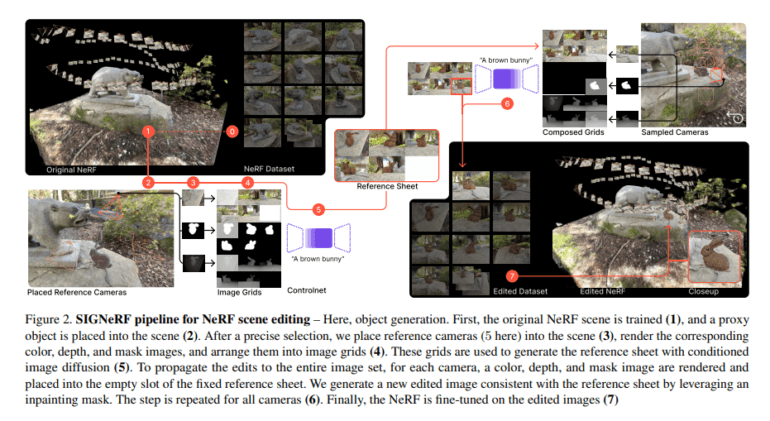TL;DR:
- Researchers from the University of Tübingen have introduced SIGNeRF, a novel AI approach for fast and precise NeRF scene editing and object generation.
- NeRF technology has transformed 3D content creation, but scene editing has been complex and inconsistent until now.
- SIGNeRF utilizes generative 2D diffusion models and reference sheets to achieve rapid, controllable, and realistic edits in 3D scenes.
- The use of depth maps provides precise spatial control, enhancing the accuracy of edits.
- SIGNeRF outperforms existing methods in realism, control, efficiency, and flexibility.
- It opens new possibilities in virtual and augmented reality applications, making NeRF scene editing more practical.
- SIGNeRF exemplifies the potential of combining neural networks with image diffusion models.
Main AI News:
In a groundbreaking development, researchers from the University of Tübingen have introduced SIGNeRF (Scene Integrated Generation for Neural Radiance Fields), a cutting-edge AI approach designed to streamline and enhance the process of NeRF scene editing and scene-integrated object generation. Neural Radiance Fields (NeRF) have ushered in a new era of 3D content creation, offering unparalleled realism in virtual and augmented reality applications. However, the task of editing these scenes has long been a complex and laborious endeavor, often entailing intricate procedures and yielding inconsistent outcomes.
The existing landscape of NeRF scene editing is fraught with various methods, some of which excel in specific areas but ultimately fall short when it comes to delivering precise and rapid modifications. Conventional techniques, such as object-centric generative approaches, grapple with the complexities of real-world scenes, resulting in edits that lack authenticity and coherence.
In response to these challenges, the research team from the University of Tübingen presents SIGNeRF, an innovative approach that leverages generative 2D diffusion models to revolutionize NeRF scene editing. What sets SIGNeRF apart is its remarkable capacity to produce swift, controllable, and consistently realistic edits within 3D scenes. Unlike previous methods that relied on iterative optimization, SIGNeRF introduces a reference sheet of modified images. These images, once processed through a diffusion model, seamlessly update the NeRF image set, ensuring a seamless integration of the edited elements with the original scene.
A deeper dive into the methodology of SIGNeRF reveals its transformative impact on NeRF editing. The process commences with the creation of a multi-view reference sheet, capturing various angles of the intended edit. When fed into a depth-conditioned diffusion model, this reference sheet guides the update of the NeRF image set, guaranteeing 3D consistency across all perspectives. The innovative use of depth maps in this process grants precise control over spatial locations, resulting in edits that are not only accurate but also exceptionally realistic.
The performance of SIGNeRF is nothing short of impressive, as demonstrated by rigorous testing and comparisons. It consistently outperforms existing methods in terms of creating realistic and coherent scene modifications. This exceptional approach excels in multiple dimensions:
- Realism: Edits seamlessly integrate into the original scenes, upholding the photorealistic quality for which NeRF is renowned.
- Control: The incorporation of a reference sheet and depth maps provides unprecedented precision and control over edits, a feat previously unattainable with other methods.
- Efficiency: SIGNeRF significantly reduces the time and complexity associated with NeRF scene editing, making it a highly practical tool for real-world applications.
- Flexibility: This method’s remarkable ability to generate new objects within a scene and modify existing ones while preserving the overall structure and appearance underscores its versatility.
SIGNeRF represents a pivotal advancement in the realms of computer graphics and 3D rendering, yielding a multitude of contributions:
- It offers a rapid and efficient solution to the intricate task of NeRF scene editing.
- Its modular nature renders it adaptable for diverse applications in virtual reality, augmented reality, and beyond.
- SIGNeRF serves as a prime example of the potential inherent in combining neural networks with image diffusion models, paving the way for future innovations in 3D content creation.
- This research not only augments the capabilities of NeRF but also ushers in a realm of creative and practical possibilities in 3D scene generation.

Source: Marktechpost Media Inc.
Conclusion:
SIGNeRF represents a game-changing advancement in the 3D content creation market. Its rapid, efficient, and precise scene editing capabilities open up opportunities for businesses in virtual and augmented reality, offering enhanced realism and flexibility. The fusion of neural networks and diffusion models indicates a promising future for innovation in this field, positioning businesses for growth and success.

